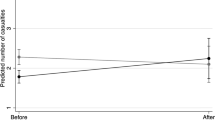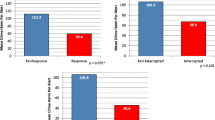Abstract
Objectives
The existence of bias in law enforcement can be difficult to verify or disprove, in part because of the difficulty of finding a benchmark—an objective estimate of actual offenses committed by the studied population—that can be compared with police enforcement. In the current study, we propose and test a method for examining bias in enforcement of speeding offenses.
Method
Using all speeding tickets issued in Israel in 2013–2015, we compare speeding tickets generated by stationary automatic traffic cameras, which provide an objective estimate of speed offenses, with speeding tickets issued manually by police officers, based on drivers’ ethnicity with further distribution by gender and age.
Results
Initial findings indicate that, overall, speeding tickets issued by police officers in Israel are not biased based on drivers’ ethnicity.
Conclusions
This study highlights the importance of distinguishing between overrepresentation and bias in law enforcement, which sometimes seem to be blurred in the literature.

Similar content being viewed by others
Notes
The data were provided by the Transport Department of the Israel Police. The police data link traffic tickets data with information from the National Civil Registration on drivers’ religion, age and gender, both for the automated speed cameras and the manual laser speedometer.
The model can be also interpreted as follows: given that a driver was caught speeding and received a ticket, is the probability that he/she is non-Jewish similar regardless of the source of the report (manual or automatic) while controlling for the other variables in the model.
Additional analyses without clustered robust standard errors yielded similar results.
The predictions for the non-Jewish drivers in total were estimated from Model 2 (with controls but without interactions). The predictions for the other variables were estimated from Model 8 with the interactions. However, the predictions for non-Jews in total from Model 8 yielded similar effects—23.4% (23.12–23.67%) and 18.2% (17.78–18.68%) for automatic and manual enforcement, respectively.
Data on the distribution of drivers in the population by road type and daytime/nighttime hours do not exist.
It is interesting to note that, without the control variables, the estimated proportion (from Model 1 in Table 2) of tickets issued by manual enforcement that went to non-Jewish drivers (33%) was significantly higher (\( {\chi}_1^2=726.91 \); p < 0.001) than the percentage of tickets generated automatically that went to this group (27%). See the left side of Fig. 2 in the Appendix.
References
Alpert, G. P., Dunham, R. G., & Smith, M. R. (2007). Investigating racial profiling by the Miami-dade police department: A multimethod approach. Criminology & Public Policy, 6, 25–55.
Ariel, B., & Tankebe, J. (2018). Racial stratification and multiple outcomes in police stops and searches. Policing and Society, 28, 507–525.
Bates, L., Allen, S., & Watson, B. (2016). The influence of the elements of procedural justice and speed camera enforcement on young novice driver self-reported speeding. Accident Analysis & Prevention, 92, 34–42.
Ben-Porat, G., & Yuval, F. (2011). Minorities in democracy and policing policy: From alienation to cooperation. Policing and Society, 22, 235–252.
Braver, E. R. (2003). Race, Hispanic origin, and socioeconomic status in relation to motor vehicles occupant death rates and risk factors among adults. Accident Analysis and Prevention, 35, 295–309.
Cameron, C. A., & Miller, D. L. (2015). A practitioner's guide to cluster-robust inference. Journal of Human Resources, 50, 317–372.
Central Bureau of Statistics. (2016). Licenced to drive 2015. Jerusalem: Central Bureau of Statistics.
Central Bureau of Statistics. (2017). Annual data 2016. Jerusalem: Central Bureau of Statistics.
Cochran, J. C., & Warren, P. Y. (2012). Racial, ethnic, and gender differences in perceptions of the police: The salience of officer race within the context of racial profiling. Journal of Contemporary Criminal Justice, 28, 206–227.
Correll, J., Park, B., Judd, C. M., Wittenbrink, B., Sadler, M. S., & Keesee, T. (2007). Across the thin blue line: Police officers and racial bias in the decision to shoot. Journal of Personality and Social Psychology, 92, 1006–1023.
Durose, M. R., Smith, E. L., & Langan, P. A. (2007). Contacts between police and the public, 2005. DC: Washington.
Factor, R., Mahalel, D., & Yair, G. (2008). Inter-group differences in road-traffic crash involvement. Accident Analysis and Prevention, 40, 2000–2007.
Factor, R., Yair, G., & Mahalel, D. (2010). Who by accident? The social morphology of car accidents. Risk Analysis, 30, 1411–1423.
Factor, R., Awerbuch, T., & Levins, R. (2013a). Social and land use composition determinants of health: Variability in health indicators Health and Place, 22, 90–97.
Factor, R., Mahalel, D., Rafaeli, A., & Williams, D. R. (2013b). A social resistance perspective for delinquent behavior among non-dominant minority groups. The British Journal of Criminology, 53, 784–804.
Factor, R. (2018). An empirical analysis of the characteristics of drivers who are ticketed for traffic offences. Transportation Research Part F: Traffic Psychology and Behaviour, 53, 1–13.
Factor, R. (2019). A quasi-experiment testing a public participation process for designing and implementing an enforcement program among minorities. Journal of Experimental Criminology, 15, 77–86.
Ferrandino, J. (2015). Minority threat hypothesis and nypd stop and frisk policy. Criminal Justice Review, 40, 209–229.
Fox, J. (2008). Applied regression analysis and generalized linear models. Los Angeles: Sage.
Gelman, A., Fagan, J., & Kiss, A. (2007). An analysis of the New York city police department's “stop-and-frisk” policy in the context of claims of racial bias. Journal of the American Statistical Association, 102, 813–823.
Gilliard-Matthews, S., Kowalski, B. R., & Lundman, R. J. (2008). Officer race and citizen-reported traffic ticket decisions by police in 1999 and 2002. Police Quarterly, 11, 202–219.
Grogger, J., & Ridgeway, G. (2006). Testing for racial profiling in traffic stops from behind a veil of darkness. Journal of the American Statistical Association, 101, 878–887.
Hasisi, B., & Weitzer, R. (2007). Police relations with Arabs and Jews in Israel. British Journal of Criminology, 47, 728–745.
Hurwitz, J., & Peffley, M. (2005). Explaining the great racial divide: Perceptions of fairness in the U.S. criminal justice system. The Journal of Politics, 67, 762–783.
Jonathan-Zamir, T., & Harpaz, A. (2018). Predicting support for procedurally just treatment: The case of the Israel national police. Criminal Justice and Behavior, 45, 840–862.
Kalinowski, J., Ross, S. L., & Ross, M. B. (2017). Endogenous driving behavior in veil of darkness tests for racial profiling. Chicago, IL: Group, H.C.a.E.O.G.W.
Kochel, T. R., Wilson, D. B., & Mastrofski, S. D. (2011). Effect of suspect race on officers’ arrest decisions. Criminology, 49, 473–512.
Lange, J.E., Blackman, K.O., & Johnson, M.B. (2001). Speed violation survey of the New Jersey turnpike : Final report. Calverton, Md.:
Lundman, R. J., & Kaufman, R. L. (2003). Driving while black: Effects of race, ethnicity, and gender on citizen self-reports of traffic stops and police actions. Criminology, 41, 195–220.
Maxfield, M. G., & Babbie, E. R. (2015). Research methods for criminal justice and criminology. Stamford, CT: Cengage Learning.
Ministry of Public Security. (2018). Traffic enforcement cameras URL. https://www.gov.il/he/Departments/General/traffic_enforcement_cameras (accessed: May).
Mitchell, O., & Caudy, M. S. (2015). Examining racial disparities in drug arrests. Justice Quarterly, 32, 288–313.
Pampel, F.C. (2000). Logistic regression: A primer. (Thousand Oaks, Calif.: Sage publications.)
Petrocelli, M., Piquero, A. R., & Smith, M. R. (2003). Conflict theory and racial profiling: An empirical analysis of police traffic stop data. Journal of Criminal Justice, 31, 1–11.
Quintanar, S. M. (2017). Man vs Machine: An investigation of speeding ticket disparities based on gender and race. Journal of Applied Economics, 20, 1–28.
Ridgeway, G. (2007). Analysis of racial disparities in the New York police department's stop, question, and frisk practices.
Rojek, J., Rosenfeld, R., & Decker, S. (2012). Policing race: The racial stratification of searches in police traffic stops. Criminology, 50, 993–1024.
Schechtman, E., Bar-Gera, H., & Musicant, O. (2016). Driver views on speed and enforcement. Accident Analysis & Prevention, 89, 9–21.
Semyonov, M., Raijman, R., & Yom-Tov, A. (2002). Labor market competition, perceived threat, and endorsement of economic discrimination against foreign workers in Israel. Social Problems, 49, 416–431.
Shinar, D. (2007). Traffic safety and human behavior. (Amsterdam ; Boston: Elsevier.)
Smith, M. R., Makarios, M., & Alpert, G. P. (2006). Differential suspicion: Theory specification and gender effects in the traffic stop context. Justice Quarterly, 23, 271–295.
Smith, W.R., Tomaskovic-Devey, D., Zingraff, M.T., Mason, H.M., Warren, P.Y., & Pfaff Wright, C. (2004). The North Carolina highway traffic study.
Solis, C., Portillos, E. L., & Brunson, R. K. (2009). Latino youths' experiences with and perceptions of involuntary police encounters. The Annals of the American Academy of Political and Social Science, 623, 39–51.
Taniguchi, T. A., Hendrix, J. A., Levin-Rector, A., Aagaard, B. P., Strom, K. J., & Zimmer, S. A. (2017). Extending the veil of darkness approach: An examination of racial disproportionality in traffic stops in Durham, NC. Police Quarterly, 20, 420–448.
Terrill, W., & Reisig, M. D. (2003). Neighborhood context and police use of force. Journal of Research in Crime and Delinquency, 40, 291–321.
Waddington, P.a. J., Stenson, K., & Don, D. (2004). In proportion: Race, and police stop and search. British Journal of Criminology, 44, 889–914.
Warren, P., Tomaskovic-Devey, D., Smith, W., Zingraff, M., & Mason, M. (2006). Driving while black: Bias processes and racial disparity in police stops. Criminology, 44, 709–738.
Weisburd, D., & Majmundar, M. K. (2018). Proactive policing: Effects on crime and communities. Washington, DC: The National Academies Press.
Weitzer, R., & Tuch, S. A. (2005). Determinants of public satisfaction with the police. Police Quarterly, 8, 279–297.
Wooldridge, J. M. (2003). Cluster-sample methods in applied econometrics. The American Economic Review, 93, 133–138.
Worden, R. E., McLean, S. J., & Wheeler, A. P. (2012). Testing for racial profiling with the veil-of-darkness method. Police Quarterly, 15, 92–111.
Yagil, D. (1998). Gender and age-related differences in attitudes towards traffic laws and traffic violations. Transportation Research Part F: Traffic Psychology and Behaviour, 1, 123–135.
Yirmiyahu, A., Rubin, O. D., & Malul, M. (2017). Does greater accessibility to higher education reduce wage inequality? The case of the Arab minority in Israel. Studies in Higher Education, 42, 1071–1090.
Author information
Authors and Affiliations
Corresponding author
Additional information
Publisher’s note
Springer Nature remains neutral with regard to jurisdictional claims in published maps and institutional affiliations.
Rights and permissions
About this article
Cite this article
Factor, R., Kaplan-Harel, G., Turgeman, R. et al. Overcoming the benchmark problem in estimating bias in traffic enforcement: the use of automatic traffic enforcement cameras. J Exp Criminol 17, 217–237 (2021). https://doi.org/10.1007/s11292-020-09414-1
Published:
Issue Date:
DOI: https://doi.org/10.1007/s11292-020-09414-1





